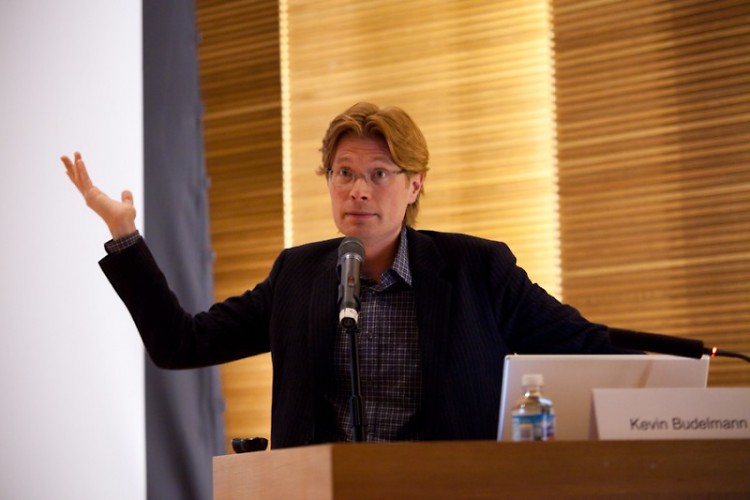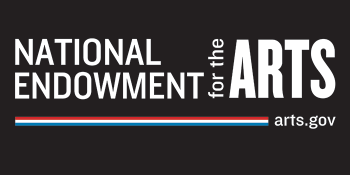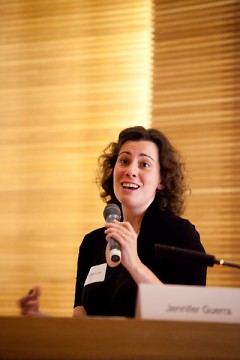This past weekend, the Grand Rapids Art Museum hosted the Film Art & Literature Symposium, promising a conversation about “The Michigan Perspective.” As both a recent Michigan transplant and an artist interested in how geography affects community engagement, I hoped that the conference might offer insight for navigating my new cultural terrain.
This need to define place strikes me as a very American urge. The ink is barely dry in our history books, so Americans perhaps more than others have more freedom in constructing and projecting an image of their given places. It was America, after all, who gave the world its first national park (so our trees are the ones that come with plaques and brochures).
Defining a local perspective is a tall order, if not impossible today as many of us have a fractured, even dislocated sense of place.
During the conference, I was on the look-out for contemporary and place-specific elements that might distinguish our Michigan creative culture from others. I came away with some broad characteristics that Michigan culture-makers share, but I was more struck by what the conference seemed to uncover as lacking in our creative community The below three areas call for our attention:
1. Contextualization: Acknowledging commonalities is not enough. Artists must clearly articulate a context for their own work and make sense of what others around them are doing.
Keynote speaker and President of Peopledesign Kevin Budelmann introduced the conference with a mandate to both arts institutions and artists. Arts institutions, he suggested, should see themselves as educators. Referencing the Occupy Wall Street folks, Budelmann urged the creatives in the 99% to communicate their value and their message clearly, especially when asking for money. As president of a design consultancy firm, Budelmann offered a unique, somewhat outsider’s perspective on contextualization. While artists, feeling like cattle, may view “branding,” as something inflicted upon them, Budelmann implied that artists ought to be collectively concerned whether they are noticeable and whether or not people care what we’re up to. He concluded his lecture by posing the question, Will we be the sum of our actions, or will we collaboratively define ourselves? I can safely assume that a designer’s answer may hinge on intentional communication, but artists may beg to differ.
In the Artist’s round table panel, two of the four artists could not speak to how their work fit into a local, or even larger, context. Sculptor Jason Quigno admitted that he locked himself in his studio and was unaware of art movements. Artist, designer and community activist Georgia Taylor was stumped when asked to describe her work. She mused broadly, “It’s about humanity? The self?” While Taylor’s Studio 477 undoubtedly offers valuable resources by providing professional support for underrepresented young artists, context seems to play little part in her own work. Neverthless, the act of bringing artists together at Studio 477, this symposium, and other nonprofit initiatives like Sunday Soup and ArtPeers is crucial to hammering out a collective identity.
2. Value: Advocating the value of one’s work within a local context is problematic but essential.
As conference speakers and participants alike noted, we Michiganders view ourselves provincially. Budelmann gave the illustration that someone from Wyoming, Michigan might not claim Grand Rapids and furthermore, proclaiming Wyoming as home to another Michigander would never conjure up images of the Tetons. We readily acknowledge that we belong within small boundaries, yet most ambitious artists would cringe at the label of “local artist.” Local has problematic connotations. To “know your place” is to know your limits, where you don’t belong. Seeing oneself as a local service provider (akin to a plumber or a dentist) might seem an act of de-valuing one’s work. Artists have to allow themselves to be multi-centered, grounding themselves in the local community while stretching beyond its perimeters, though not always simultaneously.
While moderating the Artist’s round table panel, Tommy Allen likened artists to bomb detonators. They go into culturally desolate spaces, clear the detritus, and set up shop. But as we’ve seen happen in SoHo, the studio spaces and bohemian coffee shops soon become luxury lofts and martini bars unaffordable to artists. So while artists add value, they rarely reap the benefits—monetarily, at least. Jennifer Guerra of Michigan Radio highlighted several projects in Flint and Detroit that re-imagine blight as exhibition spaces and community centers. While the transformative value of artists may be more apparent in communities like Flint and Detroit who desperately need both soul and face-lift, artists in cities like Grand Rapids must advocate for themselves and their value.
Some practical suggestions offered were strategic and selective agreement to donations, to create bodies of work wherein lies the commodity or creating unique exhibition opportunities. We could all work together to expand this list.
3. Criticism: We cannot demand that art have a context and value without prioritizing critical discourse.
Curiously lacking from this symposium were the voices of critics and curators. With the slow death of paper media, the paid profession of critic and/or arts writer has become what Hrag Vartanian calls “a career path for the masochistic.”
So what is the solution to infusing more critical discourse, if critics and curators are not present? During his ArtPrize lecture, Sculpture Magazine editor Glenn Harper prescribed what he saw as the only viable solution to this post-art critic, post-movement era: Artists themselves must create their own philosophy for why their work exists. They must be maker and critic. Artists are not always the best at defining their work, but they can collectively make sense what’s going on in their midst. Taking a look at- heck, even collaborating with- art communities that lie beyond our own metropolis might solidify our unique contributions while being stretched by others.
It’s a heavy burden to be an artist engaged in local community—to create one’s own context, value and criticism within the community where you buy your groceries. But Michigan, like much of America, continues to beg for cultural definition. So long as we continue to ask new acquaintances “where are you from,” we can’t deny the pull of geographical place that operates in each of us. The burden of making sense of our locale in our individual creative efforts and within our local communities is an innate and worthwhile effort.
The Rapidian, a program of the 501(c)3 nonprofit Community Media Center, relies on the community’s support to help cover the cost of training reporters and publishing content.
We need your help.
If each of our readers and content creators who values this community platform help support its creation and maintenance, The Rapidian can continue to educate and facilitate a conversation around issues for years to come.
Please support The Rapidian and make a contribution today.



Comments
I think it can be a useful endeavor for artists to periodically ask themselves how they see their work and themselves within the context of their local environment and also larger movements or styles. When artists interact with other artists' work by going to shows and simply hanging out together, over time a cross-pollination occurs and location-based styles and movements sometimes flourish.
Six months ago, I moved into a work/live space on the Avenue for the Arts part of Grand Rapids (Division Avenue from Fulton to Wealthy Streets). A few years ago I became involved with ArtPeers. Both of these organizations have opened up many more possibilities in terms of branding, exhibiting, meeting other artists, and becoming involved in the community. However, I still wrestle with the artistic diversity of their all-encompassing umbrellas.
Personally, when I was a student, defining myself and my work was very easy. Now that I am "out on my own", it's a constantly evolving process. While my time is limited by the necessity of holding a day job, this also gives me the freedom to follow what interests me, without the concern of market viability. I have been making figurative charcoal drawings for the past couple of years, but now I am becoming interested in abstract painting. I am not unaware that this can be confusing for potential collectors, but I cannot let that prevent or limit me from going down that path. Better to do something, then define it after the fact.
This is a well written piece of criticism that I am still scratching my head over. I'm still scratching my head over the concept of the MFAL Symposium to begin with and eagerly awaiting the recorded sessions to appear online.
Do Michigan artists desire a "Michigan Perspective" or rather a community, a city, a state that is art educated and invested enough to support artists? Do we want to "articulate a context" or should we as artists demand society get their ass out of bed and do something besides watch football? Do artists have to articulate what we do more clearly as Kevin Bundelmann suggests or should we gather together and demand the end to stupid artist exploitation events such as ArtPrize?
I defy the stereotypic notion that artists are lazy, that we don't have a philosophy, that we don't communicate clearly, that we are lost little lemmings in need of marketing and business expertise. I defiy the notion that it is us that needs definition, that it is us that needs to educate you, that it is us that needs arts administrators and socioeconomists to lead us into the new Michigan.
No, my business friend, my landlord, my economic developer, my fortune 500 company, my local and regional arts administrator, my fellow person moving through life, you needs us. You need us to show you the way, to lead, to break new ground, to show you possiblilites you could never dream of, to entertain you, to feed you, to give you something other than a force fed, branded, mudane world. You need us!
There, I feel much better now.